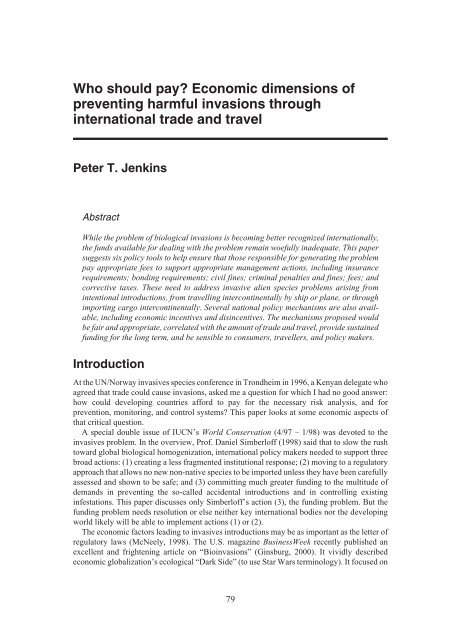Alien Species.vp - IUCN
Alien Species.vp - IUCN
Alien Species.vp - IUCN
Create successful ePaper yourself
Turn your PDF publications into a flip-book with our unique Google optimized e-Paper software.
Who should pay? Economic dimensions of<br />
preventing harmful invasions through<br />
international trade and travel<br />
Peter T. Jenkins<br />
Abstract<br />
While the problem of biological invasions is becoming better recognized internationally,<br />
the funds available for dealing with the problem remain woefully inadequate. This paper<br />
suggests six policy tools to help ensure that those responsible for generating the problem<br />
pay appropriate fees to support appropriate management actions, including insurance<br />
requirements; bonding requirements; civil fines; criminal penalties and fines; fees; and<br />
corrective taxes. These need to address invasive alien species problems arising from<br />
intentional introductions, from travelling intercontinentally by ship or plane, or through<br />
importing cargo intercontinentally. Several national policy mechanisms are also available,<br />
including economic incentives and disincentives. The mechanisms proposed would<br />
be fair and appropriate, correlated with the amount of trade and travel, provide sustained<br />
funding for the long term, and be sensible to consumers, travellers, and policy makers.<br />
Introduction<br />
At the UN/Norway invasives species conference in Trondheim in 1996, a Kenyan delegate who<br />
agreed that trade could cause invasions, asked me a question for which I had no good answer:<br />
how could developing countries afford to pay for the necessary risk analysis, and for<br />
prevention, monitoring, and control systems? This paper looks at some economic aspects of<br />
that critical question.<br />
A special double issue of <strong>IUCN</strong>’s World Conservation (4/97 – 1/98) was devoted to the<br />
invasives problem. In the overview, Prof. Daniel Simberloff (1998) said that to slow the rush<br />
toward global biological homogenization, international policy makers needed to support three<br />
broad actions: (1) creating a less fragmented institutional response; (2) moving to a regulatory<br />
approach that allows no new non-native species to be imported unless they have been carefully<br />
assessed and shown to be safe; and (3) committing much greater funding to the multitude of<br />
demands in preventing the so-called accidental introductions and in controlling existing<br />
infestations. This paper discusses only Simberloff’s action (3), the funding problem. But the<br />
funding problem needs resolution or else neither key international bodies nor the developing<br />
world likely will be able to implement actions (1) or (2).<br />
The economic factors leading to invasives introductions may be as important as the letter of<br />
regulatory laws (McNeely, 1998). The U.S. magazine BusinessWeek recently published an<br />
excellent and frightening article on “Bioinvasions” (Ginsburg, 2000). It vividly described<br />
economic globalization’s ecological “Dark Side” (to use Star Wars terminology). It focused on<br />
79












